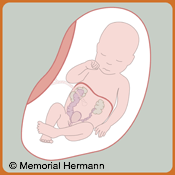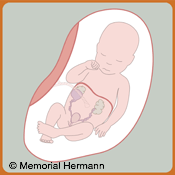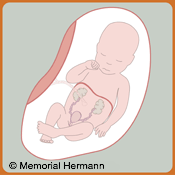What Are Urinary Tract Obstructions?

Depending on the location of the blockage, obstruction of the urinary tract causes a backup of urine into the bladder, ureters, and/or kidneys. This usually results in dilation of these structures that are seen on prenatal ultrasound.
The main concern is that blockage of urine may lead to kidney damage. Typically, if only one kidney is affected, the fetus will still do well because the other kidney is fully functional. However, in the most severe cases in which both kidneys are affected, the blocked urinary tract can cause the kidneys to stop functioning and urine production decreases or stops. Decreased urine can cause a decrease in amniotic fluid (oligohydramnios) and impaired lung development. Your physicians will determine the amount of amniotic fluid surrounding the baby by ultrasound evaluation.
What Are the Causes of Urinary Tract Obstruction?

There are many causes of urinary tract obstructions but all are due to some sort of blockage that prevents or slows urine from exiting the body. Some of the causes are:
Bladder outlet or urethral obstructions: The urethra is the small tube that allows the bladder to empty out of the body. Obstructions of the urethra cause a buildup of urine in the bladder. If this is severe, urine can backup into both ureters and kidneys. The most common cause of bladder outlet obstructions is a posterior urethral valve which is an abnormal flap or tissue in the urethra preventing urine from flowing out.
Bladder inlet or ureterovesical junction obstructions: The ureter is the tube that connects the kidneys to the bladder. This location is called the ureterovesical junction. An obstruction at this level results in a dilation of the ureter and kidney on the affected side. The other kidney and ureter are usually normal. The bladder is usually normal size because the other kidney is still making urine that flows into the bladder.
Kidney outlet or ureteropelvic junction obstructions: The pelvis of the kidney is the portion that empties urine into the ureter that eventually flows into the bladder. The ureteropelvic junction is the location where the kidney pelvis meets the ureter. Obstructions at this level cause dilation of the collecting tubules of the kidney. This is called hydronephrosis.
Ectopic ureter: This is abnormal positioning of the ureter as it comes out of the kidney or enters the bladder. This can cause a kinking of the ureter which inhibits urine flow.
Ureterocele: This is a cyst or other type of structure at the end of the ureter in the bladder that may obstruct the ureter or bladder.
How Is Urinary Tract Obstruction Diagnosed?
Urinary tract obstructions are diagnosed on routine prenatal ultrasound. The ultrasound will show a collection of fluid within the kidney or an enlarged collecting system (bladder, ureter, or kidney). Although the exact location of the blockage may not be determined, ultrasound can help determine the extent of the urinary tract obstruction as well as evaluate the kidney to determine if there is tissue damage and possible loss of function
How Is Urinary Tract Obstruction Treated?

For severe urinary tract obstruction, such as that caused by posterior urethral valves, additional intervention may be recommended to save the kidneys and/or fetus After a complete evaluation, the fetal team may decide that the best treatment for the fetus would be to insert a catheter or tube into the fetal urinary system to help drain the urine into the amniotic sac. This procedure is similar to an amniocentesis. This scenario is rare and only reserved for the most severe cases.
Your team at the Center will discuss available therapeutic options appropriate for your pregnancy.
What Special Considerations Should Be Made for Delivery?
Type of delivery: Babies with urinary tract obstructions usually do not require cesarean delivery. The delivery plan should be made between mother and her obstetrician.
Place of delivery: Depending on the severity of disease based on prenatal evaluation, your physicians at the Center may recommended that your baby be delivered at a center with all of the capabilities to take care of children with kidney problems and poor lung development such as a neonatal intensive care unit and pediatric surgery. Newborns with mild obstruction can be safely delivered at other facilities.
Time of delivery: Intentional early delivery does not improve outcome. Timing of the delivery should be carefully discussed between the mother and her obstetrician.
What Are the Long-Term Outcomes and Considerations?
The long-term outcomes of infants that are prenatally diagnosed with urinary tract obstructions depend on the cause and severity of the disease. Although most cases of hydronephrosis resolve without further treatment, the most severe cases can result in kidney failure and abnormal lung development. Depending on the severity, some babies may need corrective surgery. If the fetal lungs do not develop properly, newborns may require assistance with breathing and admission to the neonatal intensive care unit, although sometimes infants with severe lung problems do not survive.
The Center team will help care for you and your infant with urinary tract obstruction. The Center will develop a comprehensive plan with all of the physicians and specialists involved in the care of you and your newborn before, during, and after delivery.
Contact Us
When you contact The Fetal Center, you will be in touch with a dedicated coordinator who will walk you through the process step-by-step and help you to understand every aspect of your care.
The Fetal Center at Children's Memorial Hermann Hospital
UT Professional Building
6410 Fannin, Suite 210
Houston, Texas 77030
Phone: (832) 325-7288
Toll free: (888) 818-4818
Fax: (713) 383-1464
Email: thefetalcenter@memorialhermann.org
To contact The Fetal Center at Children's Memorial Hermann Hospital, please fill out the form below.
Located within the Texas Medical Center, The Fetal Center is affiliated with McGovern Medical School at UTHealth Houston, UT Physicians and Children’s Memorial Hermann Hospital.